Inton EN
From eqqon
What is Inton?
Inton is a revolutionary DIN-rail mounted sound system, most notable for its extremely small form factor, excellent audio quality, ultra-low latency, small energy footprint and perfect scalability.
Combining a network audio matrix and a public address system
Inton is a networkable 64-channel mixing matrix. The audio is transmitted between the modules in uncompressed form (at 24bit/48kHz) with a latency of only 0,1ms. Combined with a highly modular design, cost-saving DIN-rail or wall mounting and alle the functionality, that you expect a public address system to have, Inton is the perfect match for a huge amount of use cases.
We designed Inton to be EN54-16 compliant, but we have not yet certified the product. Until such time as we do, there are still a lot of use cases for it where the EN54-16 certification is not required, like for instance above-ground train stations, tunnels, airports etc.
Inton Systemkonzept
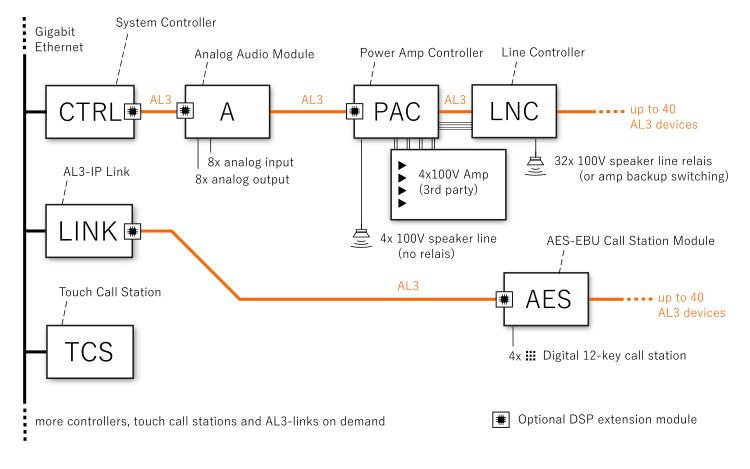
CTRL: The system controller is the central control unit of the Inton system and is connected to other parts of the system installation via IP-network. In most use cases only one or two controllers are needed per installation.
LINK: The AL3-IP-Link connects an AL3-chain with the IP-network. Due to the limitation of the number of componenets in one AL3-chain (max. 40 modules per chain) you need at least one AL3-Link per 40 modules.
TCS: Touch-Call-Station is a call station console with a touch display, that is connected to the system via IP-network.
AL3: Al3 stands for "Low-Latency-Audio-Link". It is a fast audio connection with a bandwidth of 64 channels of uncompressed audio (24bit/48kHz) with a maximum latency of 0,1ms over the whole Al3-chain. In additio to audio transport, there are also control signals transmitted over Al3.
A: The analog audio module features eight analog audio inputs and outputs. It is one of the modules that are chainable via AL3 and allows you to add as many analog inputs and outputs to the installation as you need.
PAC: The power amplifier controller allows you to integrate a four-channel 100V-amplifier into the installation and monitors it. The PAC is chainable via AL3 which gives you the power to add as many amp channels to the system as you like. Note: the four 100V-outputs of the PAC do not have a line relais. If you need line-relais (i.e. because you want to share one amp-channel between multiple lines) we are currently developing a separate relais module for that purpose that allows you to flexibly do that and also to do hot replacement of amplifier chanels in the failure case (amp backup).
AES: The AES-EBU module allows you to connect up to four AES-EBU call stations into the system. The AES module is chainable via AL3 practically allowing you to add all the call stations you need to the installation.
Efficient cabling with the new AL3 bus
Inton ist highly modular and still very simple to install. The innovative high-speed audio bus AL3 allows to use standard network cables to interconnect between system modules in a "daisy chain fashion". If you wonder how AL3 differs from other popular audio distribution network solutions like Dante, you should note that AL3 does not require costly network switches and no IP-addresses. This means you can have a lot of modules without having to worry about IP addresses and if that weren't already cool enough the modules on the AL3-bus are self organizing. It means that it does not matter at all in what order the components are chained, they will always work just like they were configured to. This is very important if you want to be able to to hot exchange of faulty components while keeping the rest of the network live.

The cost effective and simple cabling is what really empowers the highly modular system design. In turn, the fine grained modularisation has a positive effect on the installation cost because there is always just the right amount of inputs and outputs, call stations and amplifier channels.
AL3 can span up to 100m between modules using CAT5-cable (resulting in a max. AL3-chain length of 4km). If you use media converters and fiberglass cable the distance between two AL3 modules can be multiple kilometres which makes the AL3-bus very attractive for tunnels, train lines and other geographically widely spread installations.

Note that the AL3-bus is particularly well suited for tunnel installations, where you usually have amplifiers that are installed at constant distances throughout the tunnel which have to send audio with an individual delay on each channel, that is entirely depending on the position of the speaker in the tunnel, in order to avoid acoustic interferences like audio cancellation.
Even if you go to the maximum number of modules per bus, AL3 guarantees sample-synchronous audio accross all these modules. The delay between the two ends of the chain is always below 0,1 milliseconds, which is significantly below what human hearing can differentiate.
Small form factor, easy mounting
The Inton modules are so small and lightweight that it they can be mounted on a DIN-rail which is the most widely used standard mounting scheme for electrical installations. In contrast to 19"-rack mounting which is still predominant in audio installations, DIN-rail mounting helps reduce installation cost significantly. Furthermore the small form factor and the possibility of distributed installation can make a huge impact in existing or historic buildings where room for installation is often very scarce.

Decentralized Installation
Inton uses standard Ethernet cable (i.e. CAT5) for connecting its components. This allows a decentralized system installation where one or many components are broken out via AL3 or LAN/WAN.
Since AL3 is IP layer 1 it must not be routed over conventional switches. This means that the AL3-chains can not share the same cable installation as the rest of the IT. This can be a blessing because the IT can not influence the audio installation and vice verca. But sometimes it is not feasible to pull in extra cables for AL3, so we provide an alternative way of decentralized installation that makes use of existing IT cabling: Wherever the audio has to be routed over a conventional IP network with routers and switches you can convert AL3 via the AL3-IP-Link modules to an IP audio stream. Of course the ultra-low latency can not be kept up over switches and routers.
Break out modules over AL3 if pulling a separate cable is easily possible or if there is no existing IP-infrastructure. The advantage of AL3 is that you don't need any switches at all.
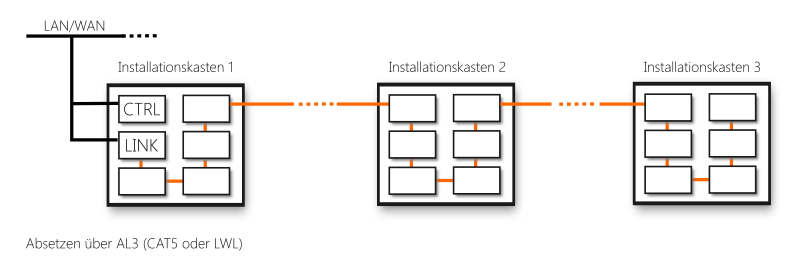
To break out modules over IP-network (LAN / WAN) makes sense, if the network should be shared with IT components or if it would not be economically feasible to pull separate cables for the audio.
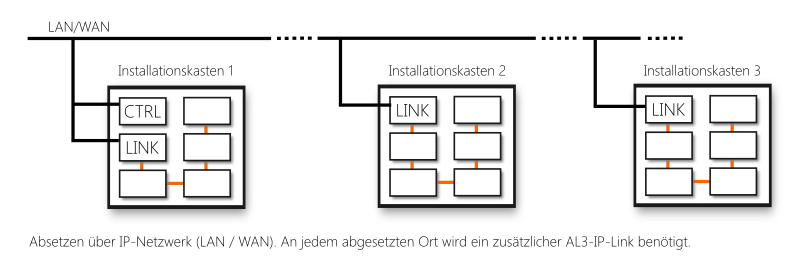
Energy Efficiency
Inton is designed to be energy efficient. Saving energy is not only good for the planet, it also reduces costs for cooling (rack climatization) as well as for emergency power supply batteries. The latter are not to be underestimated as a significant cost driver of a public address installation, which has to guarantee up to 72 hours of standby after a power outage.
In case of a power outage a small Inton installation consisting of a controller, an AL3-Link a PAC and a 4-channel amplifier can run in standby mode for 144 hours with only two standard 12V car batteries. If running in normal operation mode the same installation would still last 72 hours with the same batteries.

In other words, with Inton two standard car batteries (connected in series to provide 24V) can power an installation size of 12 speaker lines for 72 hours in standby mode.

The larger the installation, the more batteries have to be included. They need space, have to be maintained and eventually replaced after some time. That is why a highly energy efficient public address system saves you money not only with initial installation cost but also over the whole lifetime of the building.
Fine-grained Modularity Equals Excellent Scalability
Inton ist durch seinen hohen Modularisierungsgrad extrem gut skalierbar. Das bedeutet, dass mit geringer Basisstruktur durch hinzufügen entsprechender AL3-Module eine sehr große Anzahl an Verstärkerkanälen, Sprechstellen, analogen Ein- und Ausgängen etc. erreicht werden kann.
Aus dieser Eigenschaft kann sich ein enormer Kostenvorteil ergeben, z.B. im Vergleich zu Systemen, die für je vier weitere Verstärkerkanäle einen weiteren Controller benötigen.
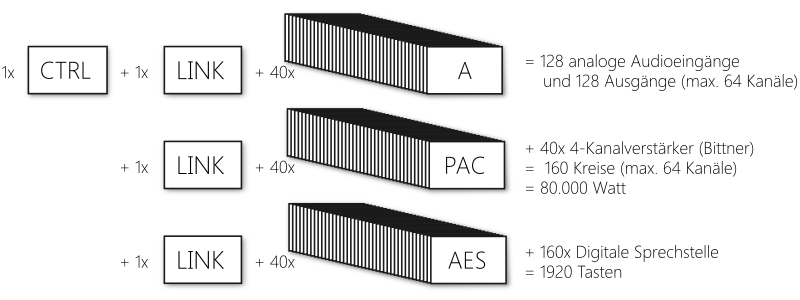
Das oben dargestellte System ist bereits sehr groß, dabei geht es noch nicht einmal annähernd an die Grenzen des Möglichen. Je nach Bedarf können weitere Al3-IP-Links hinzugenommen werden und eröffnen ihrerseits die Möglichkeit für weitere 40 Module je nach Wahl. Aber Inton skaliert nicht nur nach oben sehr gut. Es eignet sich auch für kleine Installationen:

Planung und Konfiguration
Mit dem Inton-Konfigurator können Sie mit wenigen Klicks ihr Projekt planen. Aus der Planung entsteht gleich auch die Konfiguraton, und die Projektdokumentation inklusive Blockschaltbild für die Installation. Sogar die Benutzeroberfläche der Touch-Sprechstellen können Sie schon vorab im Konfigurator erstellen. Bei der Inbetriebnahme wird mit Hilfe des Konfigurators auf Knopfdruck die gesamte Konfiguration in alle Module geladen. Konfigurator enthält zusätzlich noch viele hilfreiche Werkzeuge, die bei der Wartung und bei der Diagnose unverzichtbar sind.
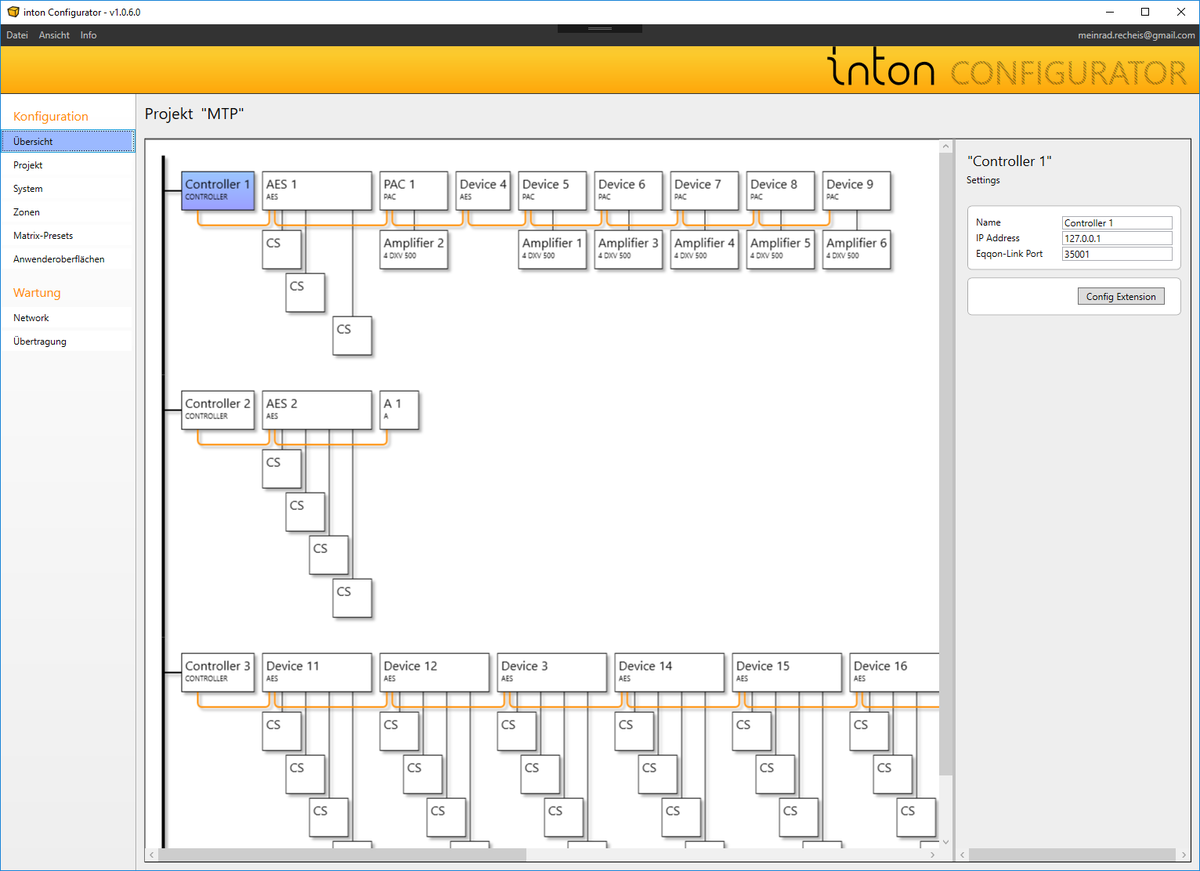
Übersicht über das Gesamtprojekt als interaktives Blockschaltbild
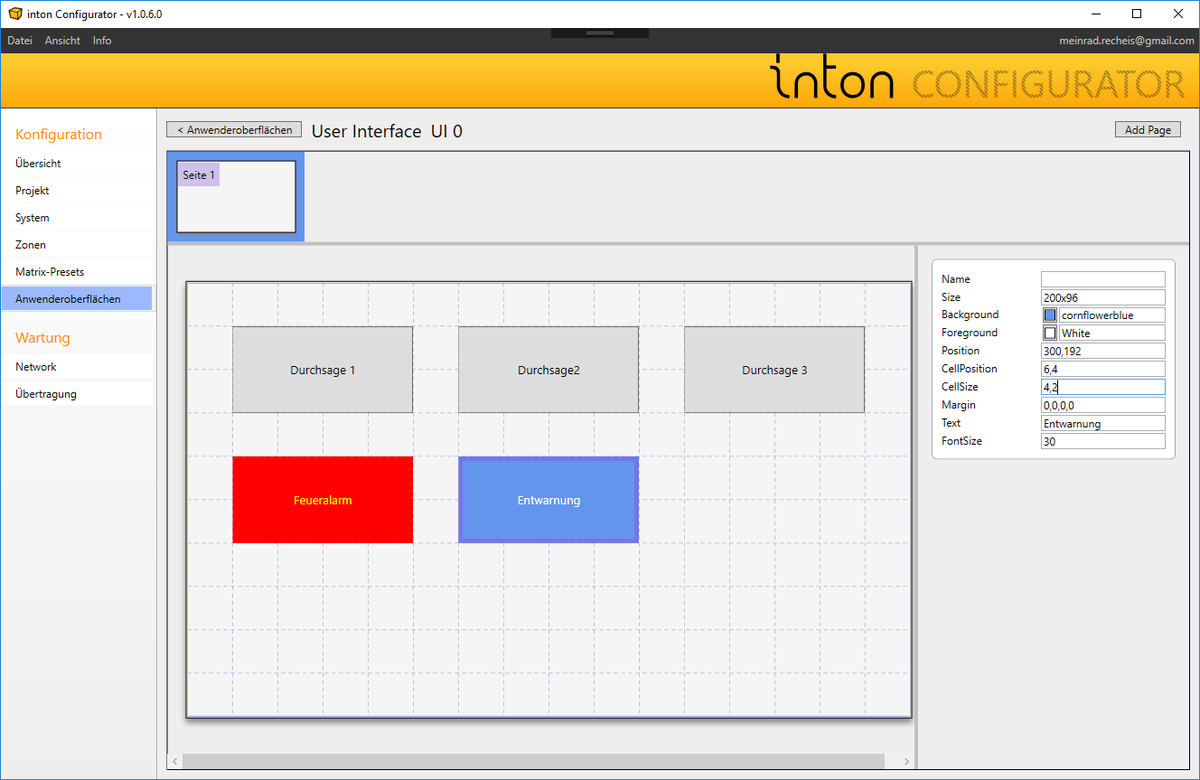
Benutzeroberflächen-Designer für die Touch-Sprechstelle